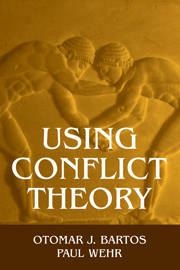Book contents
- Frontmatter
- Contents
- List of Figures and Tables
- Acknowledgments
- 1 Introduction
- 2 Understanding Conflict
- 3 Development of Incompatible Goals
- 4 Application to the Civil Rights Struggle
- 5 Emergence of Overt Conflicts
- 6 Application to a University Conflict
- 7 Escalation and Deescalation
- 8 Application to Conflict in Bosnia
- 9 Making Conflict Work Economically
- 10 Understanding and Managing Conflicts
- Appendix: Prelude to the Dissolution of Yugoslavia
- Notes
- References
- Index
7 - Escalation and Deescalation
Published online by Cambridge University Press: 05 June 2012
- Frontmatter
- Contents
- List of Figures and Tables
- Acknowledgments
- 1 Introduction
- 2 Understanding Conflict
- 3 Development of Incompatible Goals
- 4 Application to the Civil Rights Struggle
- 5 Emergence of Overt Conflicts
- 6 Application to a University Conflict
- 7 Escalation and Deescalation
- 8 Application to Conflict in Bosnia
- 9 Making Conflict Work Economically
- 10 Understanding and Managing Conflicts
- Appendix: Prelude to the Dissolution of Yugoslavia
- Notes
- References
- Index
Summary
an israeli army jeep patrols the streets of Hebron in occupied Palestine. It has been doing this for months, without incident. But today things go differently. Suddenly, a crowd of young Palestinians starts throwing rocks at the jeep. The Israeli soldiers respond with gunfire. Several youths are wounded. And an upward spiral of violence is begun. Why?
Answers to this question cannot be found in the writings of classical theoreticians. Although they spent considerable effort on the fundamental causes of conflict, they were, by and large, uninterested in its dynamics. Much more relevant for us are modern writers such as Coleman (1957), Deutsch (1973), Pruitt and Rubin (1986), and Kriesberg (1998). Their writings suggest that certain fundamental – and controversial – aspects of escalation need to be considered first.
Main Ingredients of Escalation
We may begin by asking a deceptively simple question. What makes conflict escalation different from processes considered so far? And the answer is again seemingly simple: the fact that there are two (or more) contestants – the “Party” and the “Opponent” – who interact with each other. This fact is of crucial theoretical importance, because it suggests that Party's escalation is driven by two separate forces: one that originates within the Party itself, the other that originates in its Opponent. The first force may be called “unilateral” escalation (or deescalation), the other “reciprocated” escalation (or deescalation). Let us begin by considering how these two forces contribute to the intensification of the conflict.
- Type
- Chapter
- Information
- Using Conflict Theory , pp. 98 - 121Publisher: Cambridge University PressPrint publication year: 2002



